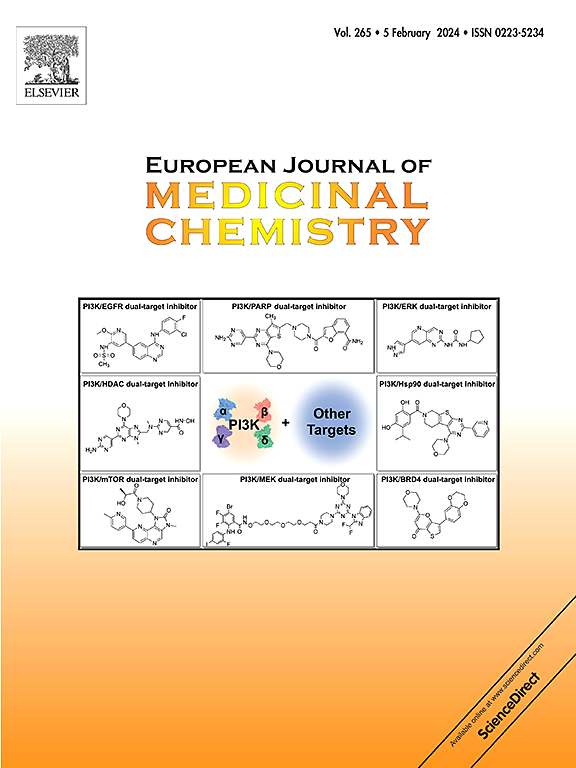Harnessing cell cycle intervention and evading P-glycoprotein efflux: natural product-inspired C2-aminophenyl chromones as dual modulators against multidrug-resistant cancer
IF 5.9
2区 医学
Q1 CHEMISTRY, MEDICINAL
引用次数: 0
Abstract
The resilience of cancer cells to current anti-neoplastic agents remains a significant challenge in oncology, underscoring the pressing requirement for novel candidates to overcome multidrug-resistant (MDR) malignancies. Building on the C2-functionalized chromone scaffold, herein, a structure-activity relationship (SAR) investigation centered on the C2-atomic bridge identified C2-aminophenyl chromone as a privileged scaffold for tumoricidal compounds. Within this chemotype, 12m and 12n emerged as promising candidates, exhibiting potent anti-proliferative activity against not only drug-sensitive KB cells (IC50 = 0.78 μM and 0.42 μM, respectively) but also MDR KBvin cells (IC50 = 0.69 μM and 0.43 μM, respectively). Mechanistic investigations revealed that both molecules effectively triggered apoptosis and hampered cell cycle transition at the G2/M stage, marked by the upregulation of cyclin B1 and cyclin A2. Moreover, 12m and 12n demonstrated collateral sensitivity and chemosynerstic interactions in MDR cancer cells, significantly suppressing P-glycoprotein (P-gp) expression while bypassing P-gp-mediated efflux. In vivo evaluations using a zebrafish xenograft model further validated their therapeutic potential in terms of KBvin tumor growth without eliciting acute toxicity at 1.0 μM. Harnessing chemoresensitizing properties, these molecules further reduced KBvin tumor burden in zebrafish when co-administered with paclitaxel. To encapsulate, the C2-aminophenyl chromone scaffold represents a novel chemical framework for the development of dual-functional anti-neoplastic agents targeting MDR cancer.

利用细胞周期干预和避免p -糖蛋白外排:天然产物激发的c2 -氨基苯酚作为多重耐药癌症的双重调节剂
肿瘤细胞对当前抗肿瘤药物的恢复能力仍然是肿瘤学的一个重大挑战,强调了迫切需要新的候选药物来克服多药耐药(MDR)恶性肿瘤。基于c2功能化的染色质支架,本文以c2 -原子桥为中心,进行了结构-活性关系(SAR)研究,确定了c2 -氨基苯基染色质作为杀肿瘤化合物的特殊支架。在该化学型中,12m和12n表现出了很好的抗增殖活性,不仅对药物敏感的KB细胞(IC50分别为0.78 μM和0.42 μM),而且对MDR KBvin细胞(IC50分别为0.69 μM和0.43 μM)都有很强的抗增殖活性。机制研究表明,这两种分子都能有效地触发细胞凋亡,并在G2/M阶段阻碍细胞周期转变,其标志是细胞周期蛋白B1和细胞周期蛋白A2的上调。此外,12m和12n在耐多药癌症细胞中表现出侧支敏感性和化学协同作用,显著抑制p-糖蛋白(P-gp)的表达,同时绕过P-gp介导的外排。使用斑马鱼异种移植模型的体内评估进一步验证了它们在KBvin肿瘤生长方面的治疗潜力,而不会引起1.0 μM的急性毒性。利用化学增敏特性,这些分子在与紫杉醇共给药时进一步降低了斑马鱼的KBvin肿瘤负荷。综上所述,c2 -氨基苯基色素支架为开发针对耐多药癌症的双功能抗肿瘤药物提供了一种新的化学框架。
本文章由计算机程序翻译,如有差异,请以英文原文为准。
求助全文
约1分钟内获得全文
求助全文
来源期刊
CiteScore
11.70
自引率
9.00%
发文量
863
审稿时长
29 days
期刊介绍:
The European Journal of Medicinal Chemistry is a global journal that publishes studies on all aspects of medicinal chemistry. It provides a medium for publication of original papers and also welcomes critical review papers.
A typical paper would report on the organic synthesis, characterization and pharmacological evaluation of compounds. Other topics of interest are drug design, QSAR, molecular modeling, drug-receptor interactions, molecular aspects of drug metabolism, prodrug synthesis and drug targeting. The journal expects manuscripts to present the rational for a study, provide insight into the design of compounds or understanding of mechanism, or clarify the targets.

 求助内容:
求助内容: 应助结果提醒方式:
应助结果提醒方式:


